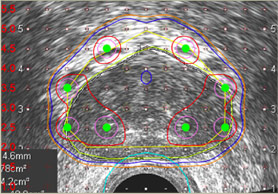Initial Consultation – What to Expect
Initial Visit
If our preliminary review of your medical records indicates that you are a candidate for seed implantation or external beam radiation, you may wish to come to Seattle for a comprehensive evaluation. As described below, this will include a thorough medical work-up, specialized ultrasound procedures, and other tests relevant to evaluating or planning radiation therapy.
In advance of your visit, we may also ask you to have your pathology (biopsy) slides sent to us so that we may review them to confirm the diagnosis.
Consultation Visit
Your consultation will include the following:
-
Physician Consultation: The radiation oncologist will perform a digital rectal exam (DRE). After reviewing your prostate specific antigen (PSA), biopsy report, physical exam findings and medical history, the radiation oncologist will determine if brachytherapy is an option for treatment. If so, a volume study will often be performed at the initial consultation to confirm that brachytherapy can be effectively performed.
You and your physician will meet for an hour or more to discuss your medical needs and treatment options. Along with an assessment of your general health status, you will talk at length about the effectiveness, complications, and possible side effects of seed implantation. You and your doctor will also discuss whether or not your treatment should combine implantation with other cancer therapies such as external beam radiation or hormonal therapy. (Three months of hormonal treatment can be required to shrink a prostate that is too large for implantation. In these cases, a follow-up volume study is scheduled to ensure that the reduction is size was sufficient for an implant to take place.) Family members are welcome to accompany.
-
Supplemental Testing: On the basis of your medical evaluation, some additional testing (e.g., bone scan or CT scan) may be necessary before a final recommendation can be made regarding your treatment. Any such tests can be done after you return home and the results forwarded to SPI.
-
 Treatment: If the decision is made by you and the radiation oncologist to proceed, an appointment will be made for the next steps of therapy. This could include a prostate ultrasound volume study for brachytherapy candidates (if not already performed) or an appointment for fiducial marker placement and simulation for external beam treatment.
Treatment: If the decision is made by you and the radiation oncologist to proceed, an appointment will be made for the next steps of therapy. This could include a prostate ultrasound volume study for brachytherapy candidates (if not already performed) or an appointment for fiducial marker placement and simulation for external beam treatment.Ultrasound Volume Study: This key procedure, carried out in our office, provides information on the size and shape of your prostate gland and forms the basis of your entire course of treatment from pre-operative planning through post-operative evaluation. During this 20-25 minute examination, an ultrasound probe is inserted into the rectum and a series of cross-sectional images is taken along the length of the prostate gland. Using sophisticated physics software, the ultrasound images are transformed by computer into a three-dimensional image that allows physicians and physics staff to plan exactly where the seeds should be placed in the prostate in order to get the maximum therapeutic benefit.
Our RN will discuss with you the preparation instructions prior to the volume study. You may take your regular medications and drive yourself to this appointment.
During the volume study, you must lie on your back with your legs placed in stirrups. Please inform us if you have a history of back surgery, back problems, and/or knee or hip replacements.
After your volume study is completed and the results are analyzed, you and your physician will make a choice regarding your course of treatment.
-
Scheduling an implant: our nursing staff will work with you to schedule a return visit. Should you require external beam radiation or hormonal treatment, we can coordinate with you. We will provide you and your local doctors with information necessary to carry out these treatment plans in preparation for the implant. Generally, the implant can be performed either before or after external beam radiation.
[to top]

